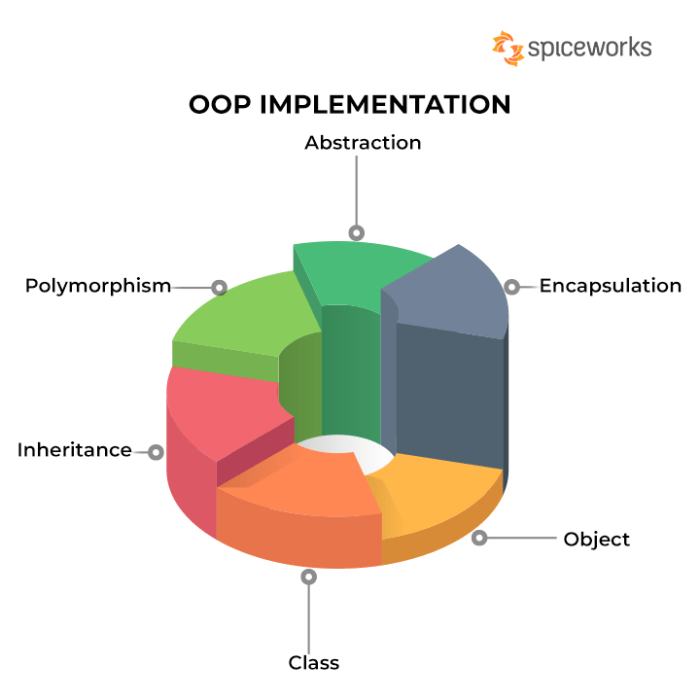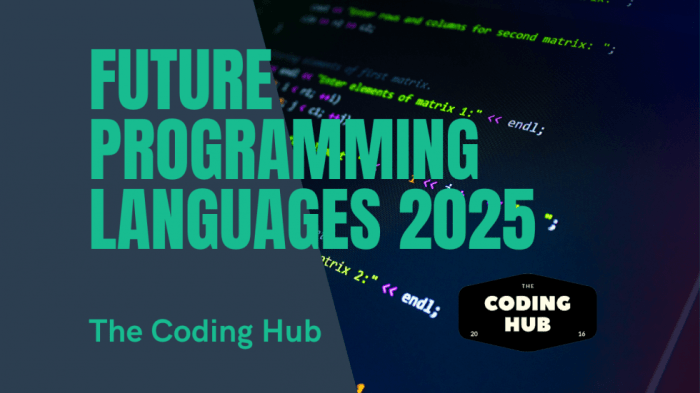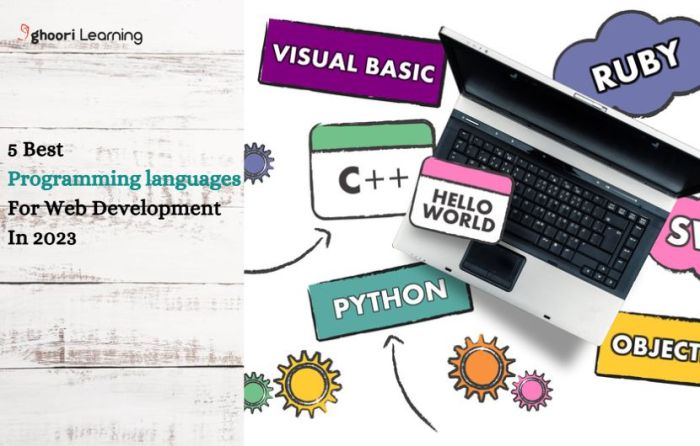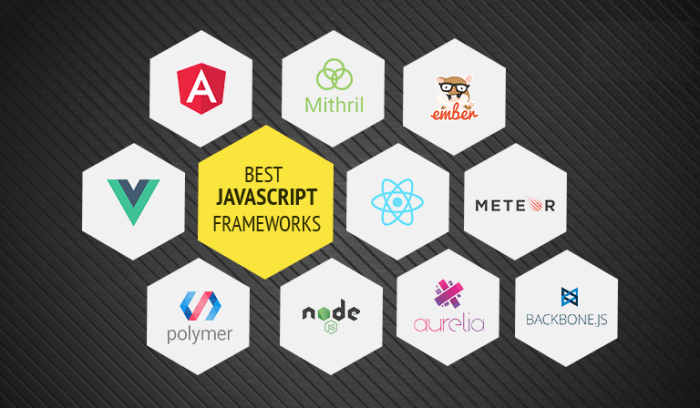
Dive into the world of Object-oriented programming concepts where we unravel the key principles, explore the realm of classes and objects, and uncover the importance of encapsulation in a captivating journey of knowledge and discovery.
Embark on this exciting adventure to understand the fundamental concepts that form the backbone of Object-oriented programming.
Object-oriented Programming Concepts
Object-oriented programming (OOP) is a programming paradigm that revolves around the concept of objects. These objects are instances of classes, which serve as blueprints for creating objects. OOP allows for the organization of code in a more modular and reusable manner.
Key Principles of Object-oriented Programming
- Inheritance: Inheritance allows a class to inherit attributes and methods from another class, promoting code reusability.
- Polymorphism: Polymorphism enables objects to be treated as instances of their parent class, providing flexibility and extensibility in the code.
- Encapsulation: Encapsulation involves bundling data (attributes) and methods (functions) that operate on the data within a class, protecting the data from external interference.
- Abstraction: Abstraction focuses on hiding the complex implementation details of a class and only exposing the necessary features to the outside world.
Classes and Objects in OOP
- Classes: Classes are user-defined data types that define the blueprint for creating objects. They encapsulate data (attributes) and methods (functions) that operate on the data.
- Objects: Objects are instances of classes, created using the class blueprint. They have their own unique data and can perform actions based on the methods defined in the class.
Importance of Encapsulation in OOP
Encapsulation plays a crucial role in OOP by ensuring data security and code maintainability. By encapsulating data within classes, OOP prevents external access to sensitive data and enforces data integrity. It also allows for easy modification of implementation details without affecting the external interface, promoting code flexibility and scalability.
Fundamental OOP Terminology

In object-oriented programming (OOP), there are several key terms that are essential to understand for effective software development. Let’s delve into the fundamental OOP terminology to grasp the core concepts.
Inheritance
Inheritance is a fundamental concept in OOP that allows a class (subclass) to inherit properties and methods from another class (superclass). This promotes code reusability and establishes a hierarchical relationship between classes. Subclasses can extend the functionality of the superclass by adding new methods or overriding existing ones.
- Inheritance promotes code reusability by allowing subclasses to inherit attributes and behaviors from a superclass.
- It facilitates the creation of a hierarchical structure among classes, enabling the organization of related classes.
- Subclasses can customize inherited methods or attributes to suit their specific requirements.
Polymorphism
Polymorphism is a key principle in OOP that allows objects of different classes to be treated as objects of a common superclass. This enables a single interface to represent multiple underlying data types. Polymorphism enhances flexibility, extensibility, and modularity in software design.
- Polymorphism enables the same method to behave differently based on the object it is called upon.
- It simplifies code maintenance and enhances scalability by accommodating new classes without modifying existing code.
- Polymorphism promotes loose coupling, reducing dependencies between classes and improving overall system design.
Abstraction
Abstraction is the process of hiding complex implementation details and representing only the essential features of an object. It focuses on what an object does rather than how it achieves its functionality. Abstraction allows developers to create a simplified model of a real-world entity in software.
- Abstraction reduces complexity by focusing on essential features and hiding unnecessary details.
- It enhances code maintainability and readability by providing a clear and concise representation of objects.
- Abstraction enables developers to create reusable components that can be easily integrated into different parts of a system.
Interfaces
Interfaces in OOP define a contract for classes to implement certain methods or behaviors. An interface specifies a set of methods that a class must implement, without specifying how they are implemented. Interfaces promote code consistency, modularity, and multiple inheritances in languages that do not support multiple class inheritance.
- Interfaces define a common set of methods that classes must implement, ensuring a consistent structure across different classes.
- They enable the implementation of multiple inheritances through the use of interface implementation.
- Interfaces promote code flexibility by allowing classes to adhere to multiple interfaces, enhancing code modularity.
Implementation in OOP

In Object-Oriented Programming (OOP), classes are used to define objects which encapsulate data and behavior. Let’s delve into how classes are implemented, the concept of constructors and destructors, data encapsulation, and how objects interact with each other in OOP.
Classes Implementation in OOP
Classes in OOP serve as blueprints for creating objects. They define the properties (attributes) and behaviors (methods) that objects of that class will have. Here’s an example of a simple class in Python:
class Car: def __init__(self, brand, model): self.brand = brand self.model = model def drive(self): print(“The car is driving.”)
In this example, the “Car” class has attributes brand and model, and a method drive(). Objects can be created from this class, each with its own brand and model attributes.
Constructors and Destructors in OOP
Constructors are special methods in a class that are automatically called when an object is created. They are used to initialize the object’s state. Constructors in Python are defined using the __init__() method. Destructors, on the other hand, are used to perform cleanup actions before an object is destroyed. In Python, the destructor method is defined using __del__().
Data Encapsulation in Classes
Data encapsulation is the concept of bundling data (attributes) and methods (behaviors) that operate on the data within a class. This helps in hiding the internal state of an object and only allows access to it through the defined methods. In OOP, encapsulation helps in achieving data hiding and abstraction.
Objects Interaction in OOP
In OOP, objects interact with each other by sending messages and calling methods. Objects can communicate with each other through method calls, where one object may invoke a method of another object. This allows for building complex systems by breaking them down into smaller, interacting objects.
Relationship between Objects
In Object-oriented programming, the relationships between objects play a crucial role in defining the structure and behavior of the system. Let’s explore the different types of relationships that can exist between objects.
Difference between Composition and Aggregation
Composition and aggregation are two types of relationships between objects in OOP.
- Composition: In composition, one object is composed of one or more other objects, and the composed objects cannot exist independently. For example, a car is composed of an engine, wheels, and other parts.
- Aggregation: In aggregation, one object is associated with one or more other objects, but the associated objects can exist independently. For example, a university has students, but the students can exist outside the university.
Concept of Association in OOP
Association represents the relationship between two or more objects where they are connected with each other in some way. It can be one-to-one, one-to-many, or many-to-many. For example, a teacher is associated with multiple students in a classroom.
Characteristics of Dependency between Objects
- Dependency: Objects depend on each other when changes in one object require changes in another object. It establishes a one-way relationship where one object uses the functionality of another object.
Establishing Relationships in OOP
In OOP, relationships between objects are established through various mechanisms like inheritance, composition, aggregation, and association. These relationships help in creating a modular, flexible, and reusable code structure.
Final Review
As we reach the end of our exploration, we have delved into the essence of Object-oriented programming concepts, gaining insights into its intricacies and applications that shape the digital landscape.
Answers to Common Questions
What is the main principle of Object-oriented Programming?
The main principle of OOP is to model real-world entities as objects that have attributes and behaviors.
How does inheritance work in OOP?
Inheritance allows a class to inherit attributes and methods from another class, promoting code reusability and organization.
What is the role of abstraction in OOP?
Abstraction allows programmers to hide complex implementation details and only show the necessary features of an object.
How are relationships between objects established in OOP?
Relationships can be established through composition, aggregation, or association, defining how objects interact with each other.







